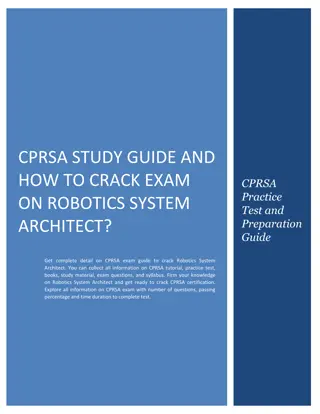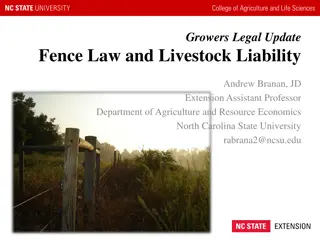Boundary and Fence Patrolling in Robotics Research
Research by Jurek Czyzowicz and team focuses on patrolling boundaries with unreliable robots to prevent intrusions. They investigate agent deployment strategies to protect terrains efficiently. The study explores optimizing visit frequencies to environmental points and coordination methods for multiple agents. Open problems and challenges in the field are outlined, including strategies for patrolling by equal-speed unreliable robots. The work delves into maximizing idle time against intruders in scenarios with faulty robots under adversary control.
Download Presentation

Please find below an Image/Link to download the presentation.
The content on the website is provided AS IS for your information and personal use only. It may not be sold, licensed, or shared on other websites without obtaining consent from the author.If you encounter any issues during the download, it is possible that the publisher has removed the file from their server.
You are allowed to download the files provided on this website for personal or commercial use, subject to the condition that they are used lawfully. All files are the property of their respective owners.
The content on the website is provided AS IS for your information and personal use only. It may not be sold, licensed, or shared on other websites without obtaining consent from the author.
E N D
Presentation Transcript
WHEN PATROLMEN BECOME CORRUPTED: FENCE MONITORING BY UNRELIABLE ROBOTS JUREK CZYZOWICZ (UNIVERSIT DU QU BEC EN OUTAOUAIS) JOINT WORK WITH L.G SIENIEC, A.KOSOWSKI, E.KRANAKIS, D. KRIZANC & N.TALEB
THE BOUNDARY PAT- ROLLING PROBLEM A set of k agents are moving on the boundary of a terrain. An intruder attempts to penetrate to the interior of the terrain through a point of the boundary, unknown to and unseen by the agents. The intrusion requires some period of time The agents aim to protect the boundary arriving before the intrusion is complete. Our scenario: Each agent has its own predefined maximal speed vi. Agents are deployed on the boundary and programmed to move around it, without exceeding their maximum speed. Question: for given (v1, v2,..., vk), does there exist a deployment of agents which protects the boundary from any intruder with intrusion time ? GRASTA October 2015
PATROLLING RESEARCH CONTEXT Patrolling is defined as the perpetual process of walking around an area in order to protect or supervise it. Efficiency measure: How to optimize the frequency of visits to the points of the environment? Idleness (refresh time) the time elapsed since the last visit of the node: average, worst-case, experimentally verified,... the largest value I, such that there exists a point p of the fence and the time t, such that point p is visited at time moments t and t+I, and not in between the smallest value I, such that for any point p of the fence and any starting time t, during the time interval [t, t+I] point p is visited at least once GRASTA October 2015
PATROLLING RESEARCH CONTEXT Coordination of multiple agents: Distributed coordination using local information exchange tokens, pebbles, white boards, ant/swarm algorithms [Yanovski et al. 2001, Elor-Bruckstein 2010] Centralized coordination two main types of heuristics [Chevaleyre 2004] GRASTA October 2015
BOUNDARY AND FENCE PATROLLING Cz. MAC 2010: Open Problems Cz., G sieniec. Kosowski. Kranakis. ESA 2011 Kawamura, Kobayashi, Dist. Computing 2015 Dumitrescu, Gosh, Toth, Electr. J. Comb. 2014 Peters, 2014 Cz. Kranakis, Pajak, Taleb SIROCCO 2014 Cz., Gasieniec, Kosowski, Kranakis, Krizanc, Taleb, ISAAC 2015 GRASTA October 2015
PATROLLING BY EQUAL-SPEED UNRELIABLE ROBOTS A collection of k robots to patrol a segment They have the same maximal speed Up to f of them may be faulty (fail to perform patrolling activity) What is the best worst-case idle time (achieved by the reliable robots) if the set of faulty robots are controlled by the adversary Equivalent setting (perhaps more realistic): We have a total number of robots more than sufficient to assure idletime beating the intruder. However some of the robots may be unreliable (faulty). Design an algorithm (a schedule) which works for maximal possible number of faulty robots. Czyzowicz, L. Gasieniec, A. Kosowski, E. Kranakis, D. Krizanc, N. Taleb, ISAAC 2016 GRASTA October 2015
UNRELIABLE ROBOTS ON A CYCLE The upper bound of (f+1)/k Robots equidistant moving clockwise around the circle (1/k distance between the neighbouring robots) The worst case when f faulty ones are consecutive (the distance between the two reliable robots is at most (f+1)/k The lower bound of (f+1)/k Let I be the idletime. Suppose that I < (f+1)/k During time I the sum of the lengths of the trajectories of all k robots is smaller than (f+1) Hence there is a point which is visited by at most f robots Making all of them faulty creates a contradiction GRASTA October 2015
PATROLLING BY UNRELIABLE ROBOTS THE UPPER BOUND Theorem 1. Consider k robots patrolling segment I = [0, 1], with at most f of them faulty where k > 2 and f < k/2 1. There exists a patrolling strategy P of I with idleness (f +1) k-(f +1) = for odd f GRASTA October 2015
PATROLLING BY UNRELIABLE ROBOTS THE UPPER BOUND Decompose the unit interval I into three segments IL, IMand IRwith pairwise disjoint interiors: 1. f 2 For each of the segments IL, IRassign robots to perform Eulerian tour of this segment. The remaining k 2 of the entire segment I. These robots are also equally spaced around I. 2. equally spaced f 2 3. robots perform the Eulerian tour GRASTA October 2015
PATROLLING BY UNRELIABLE ROBOTS THE UPPER BOUND Three sets of robots: SL, SIand SR The distance d between two consecutive robots of SI equals 2 d = k-2 f /2 Consider idle time of any point p of I GRASTA October 2015
PATROLLING BY UNRELIABLE ROBOTS THE UPPER BOUND Case 1: p in IL (or IR) 1. If at least one robot of SI is not faulty, then some robot revisits p at time intervals 2|IL|, hence we have 2. If all robots of SI are faulty, the idle time is maximized at p=0 when all remaining faulty robots are consecutive in SI. We have GRASTA October 2015
PATROLLING BY UNRELIABLE ROBOTS THE UPPER BOUND Case 2: p in IM If the streams are disjoint (separated by at least one healthy robot) the idle time is determined by the length of the shorter of the two streams. Then we have GRASTA October 2015
PATROLLING BY UNRELIABLE ROBOTS THE UPPER BOUND Case 2: p in IM Two streams of robots go in both directions across p If the streams are connected to a single faulty-robots stream, and t1 (and t2) = the time since the last (resp. until the next) visit of the healthy robot, we have GRASTA October 2015
PATROLLING BY UNRELIABLE ROBOTS THE LOWER BOUND Theorem 2. For any k and f such that f <k/2 1 we have GRASTA October 2015
PATROLLING BY UNRELIABLE ROBOTS THE LOWER BOUND Proof: Let I = (f+1)/(k-f-1). Suppose, by contradiction Ifk< I At each time moment, the sub-segment [0,I/ 2] contains at least f+1 robots, otherwise idle time of point 0 is too large. The symmetric argument holds for the sub-segment [1 -I/ 2, 1] Hence at most k-2f-2 robots are always present in the sub-segment IM = (I/ 2, 1 -I/ 2). Within any time interval of size Ifk each point of IM must be visited at least f+1 times (if not, make all robots visiting this point faulty) The sum of the trajectories lengths of the robots visiting IM within time Ifk must then be at least (f+1)|IM|. Hence one of the k-2f-2 robotsmust have the trajectory of at least (f+1)|IM| / (k-2f-2), so GRASTA October 2015
PATROLLING BY UNRELIABLE ROBOTS THE LOWER BOUND Hence we have the lower bound and the upper bound which match for odd f and almost match for even f GRASTA October 2015
THANK YOU GRASTA October 2015























